Let's create continuous conversations about climate change education: Spreading the Sediment of Science!
Share your ideas and earn a $20 gift card! 💬 Learn More
Rare Iberian Lynx No Longer Among Endangered Animals
June 26, 2024

Thought Question: What are some examples of conservation efforts you’ve seen in your community?
The Iberian lynx is one of the world’s most unique wild cats. Loss of habitat, poaching, and roadway crashes had combined to put it on the endangered list. But good news has arrived for the species. Conservation efforts have knocked it from the list.
The International Union for Conservation of Nature (IUCN) said last week that the cat with pointy ears has been removed as an endangered species. It’s now been labeled as “vulnerable.” The success comes after a steady swelling of its numbers. This species of lynx is native to Portugal and Spain.
Hefty numbers of the wild cat once roamed the Iberian Peninsula on the far edge of Southwestern Europe. But its presence started shrinking in the 1960s. The lynx's numbers comprised 62 mature members in 2001. They increased to 648 in 2022, the IUCN said. The number of young lynx has grown greatly. Now, the number of young and mature lynx combined is more than 2,000, the IUCN said.
The increase results from many efforts. They include human breeding of the cats. They also include measures to protect them. Their habitats include dense woodland, scrublands, and pastures. Restoring these places has made perhaps the most profound impact, the union said.
Craig Hilton-Taylor is head of the IUCN Red list unit. He told The Associated Press that the lynx's rebound is a huge triumph. He said that helping the wild rabbit increase its numbers also played a role in helping the lynx. The wild rabbit is the main prey of the lynx.
Francisco Javier Salcedo Ortiz runs the European Union-funded LIFE Lynx-Connect project. Ortiz called IUCN's efforts “the greatest recovery of a cat species ever achieved through conservation.”
Photo of an Iberian lynx from Reuters.





